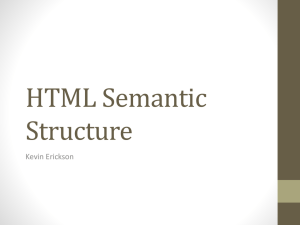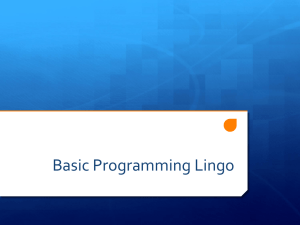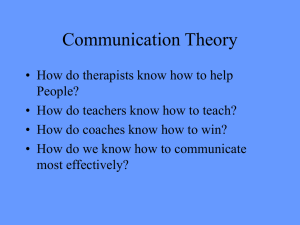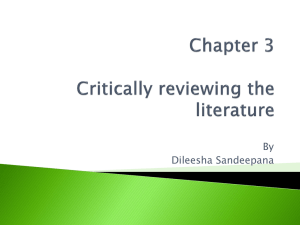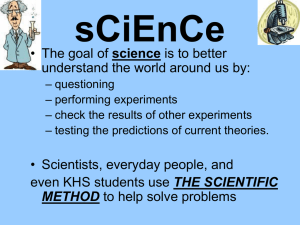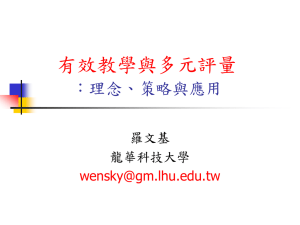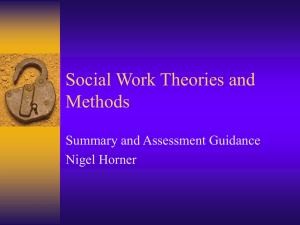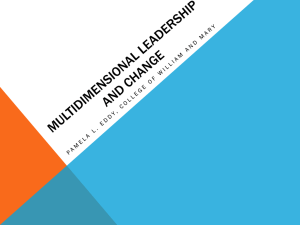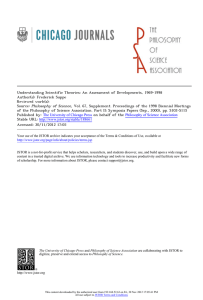A semantic conception of scientific models for didactics of science
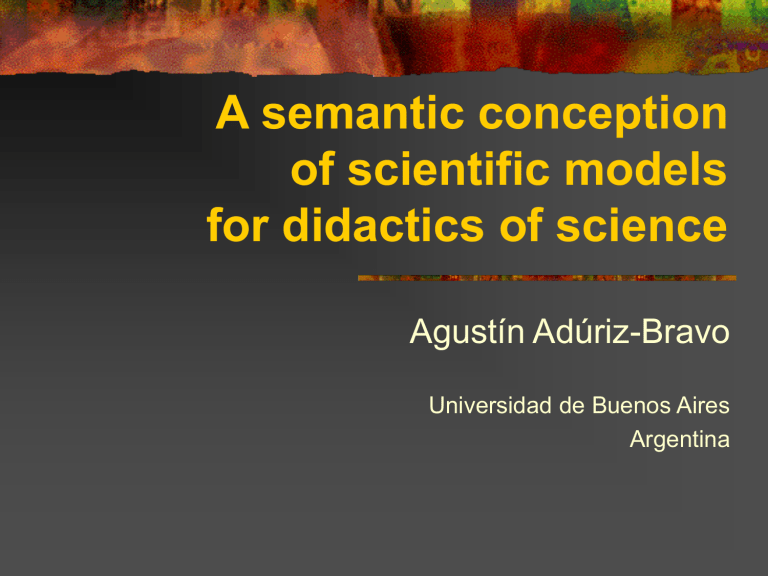
A semantic conception of scientific models for didactics of science
Agustín Adúriz-Bravo
Universidad de Buenos Aires
Argentina
The ‘modelistic turn’ in science education
Scientific models and modelling have been present in an implicit way in science curricula.
In science classes, it has been usual to work with the idea that science ‘models’ the world using abstract representations.
In the last 10 years science education researchers, science curriculum developers, and science teachers have advocatet for an explicit treatment of this construct in the classroom.
A new requirement emerges: there should be discussion around the role of models when talking about the nature of science.
The ‘modelistic turn’ in didactics of science
There is a need to make theoretical decisions on which views on models – of the many available from philosophy of science – can valuable for research, teaching, and teacher education.
I will argue in favour of a semantic conception of scientific models .
Semantic views on models
Any one of a number of recent characterisations of the concept of model proposed by a range of philosophers that can be situated in the
‘ semantic conception of scientific theories ’ , opposed to the ‘ received view ’ in the philosophy of science.
Within such school, several ‘ versions ’ can be identified: from meta-theoretical structuralism to the more recent model-based approaches by
Fred Suppe, Bas van Fraassen and Ron Giere, going through several other proposals.
Characterisation of the semantic conception
The focus of meta-theoretical analysis is put in how scientific theories give meaning to the world and make sense to their users.
A scientific theory can be fruitfully characterised as a family or class of models.
The theory is constituted not only of a class of models, but also of a set of empirical systems that such theory intends to account for.
The theory states that there is substantive relationship between its models and its systems: it ‘empirically asserts’ that some phenomena are adequately accounted for by the models.
Outline
Higlighting the merits of a semantic conception of models for science education and didactics of science requires a characterisation of how models have been conceptualised by different philosophical schools in the
20th century which in turn requires facing the obstacle that the term ‘model’ is used in the natural language, in science and technology, and in the philosophy of science with a range of different meanings.
Models in natural language
P1: “Mona Lisa Gherardini del Giocondo posed as a model for Leonardo da
Vinci” .
P2: “This toy car is an accurate model of a
Formula 1 car”.
Models in everyday life reality representation
Models in everyday life input output
Models in everyday life input output
Models in everyday life modelfor model-from
Four ‘kinds’ of models
A model-input can be a model-for when it is a paradigm : an archetype or exemplar for something, a canon that should be followed, imitated, or copied.
“ Mother Teresa of Calcutta is a model of humanitarianism ” .
Four ‘kinds’ of models
A model-input can also be a model-from, when it is an instance : a case, realisation or embodiment of something, a representative example of a general or abstract situation or of a set of principles.
“ Amsterdam is a model sustainable city ” .
Four ‘kinds’ of models
A model-output can be a model-from when it is a copy : a simplified version, replica, sketch, imitation or simulation of something. In this case, the model only captures some central and characteristic elements of what is being ‘ copied ’ chosen according to an intentional view.
“ Students participated in a model of the United
Nations ” .
Four ‘kinds’ of models
A model-output can also be a model-for when it is a design: a plan, project, scheme, prototype, blueprint or scale model of something that does not materially exist so far.
“ The exhibition features a model of the underwater tunnel ” .
Model-input-for
A pendulum is a real object that is studied by physics in order to abstract the laws of its movement.
Model-input-from
A pendulum is a real object that (best) exmplifies the physical notion of harmonic oscillations.
Model-output-from
A pendulum is a highly stylised and simplified representation of a swinging object.
Model-output-for
A pendulum is a set of specifications to understand/construct artifacts with predictable behaviour.
Models in scientific research
‘Model’ denotes a theoretical representation of a complex reality that is developed to facilitate the study of its behaviour.
abstract, symbolic, theory-laden praxis: mediation
Philosophical analyses on models
For logical positivism and the received view (c. 1920-1960), a scientific model was any example of a theory; the theory was considered the central entity for epistemological analysis.
The pendulum is one system – out of a pool of many other systems – that obeys some particular laws of mechanics.
Philosophical analyses on models
For the new philosophy of science (c. 1950-
1980), the model became a paradigmatic example (i.e., particularly worthy of imitation) of a theory.
The pendulum embodies the main characteristics of simple harmonic motion, and thus serves as exemplar to understand other systems.
Philosophical analyses on models
Finally, for the semantic conception of scientific theories (c. 1970 – 2010), the model was identified with an intended example of a theory (that is, an example that the theory is conceived to explain).
The pendulum is one system – out of a pool of very few systems – for which some specific laws of mechanics are proposed.
The semantic view adds, to the Kuhnian reconstruction of models as ‘cases’ that have been well solved and are thus exemplary, the more classical requirement that they can all be represented in analogous semi-formal ways, and formulated as generally and abstractly as possible.
Thus, semanticism represents a ‘third way’ between the received view and the new philosophy of science, purporting to recur to their most powerful tools to think about models.
[T]his ‘double strategy’ –that pretends to recover the best of each of the preceding periods– constitutes one of the fundamental characteristics of this [semanticist] approach.
(Lorenzano 2001: 38)
The semantic view synthesises in one construct the meanings model-for and modelfrom.
‘Model’ combinedly capture the two different
(and, to common sense, somewhat opposed) meanings of the Latin word ‘modus’. Modus means both ‘manner’ and ‘measure’.
A manner is to a certain extent identifiable with model-for, since it is the way in which something exists or occurs.
A measure is to a certain extent identifiable with modelfrom: it is a degree, intensity, proportion, or correspondence by comparison.
Every manner is a measure: that an embodied set of characteristic properties can serve as a canon (unit/pattern) for other embodiments or ‘realisations’ to be compared with.
A scientific model captures essential elements of a system and becomes a way of (analogically) understanding other systems.
The semantic view is compatible with both a realist reconstruction of science, and with empiricist or instrumentalist reconstructions of science.
As Fred Suppe (2000, p. S105) puts it,
[d]epending on mapping relationships [between models and phenomena] required for theoretical adequacy, realist, quasi-realist or antirealist verions
[of the semantic conception of theories] are obtained.
Giere, Suppe and van Fraassen shift their interest towards how scientific theories give meaning to the world on which they are applied, and how they make sense for those who are applying them (the ‘ cognitive agents ’ , including students and teachers).
They are less interested in the strict logical and linguistic structure of theories.
Opposing the usual syntactic approach, they prioritise a semantic, pragmatic and rhetorical approach.
G, S and vF assume that theories cannot be reduced just to the theoretical propositions that constitute them; rather, theories also contain the facts interpreted by them.
Scientific theories are not reducible to knowledge of propositional nature, since they also contain a ‘knowhow’ around the explanations and interventions that can be performed with them.
A theory is therefore a family of models, but more than the addition of these models, because these are linked by logical and experimental relationships that give coherence to the whole set.
G, S and vF consider that theories are best identified and characterised by their corresponding classes of models.
They deem more relevant to meta-theoretically study models than theories. This kind of approach is called ‘ model-based ’ .
The focus is now placed on understanding the nature of scientific models, rather than on placing these models within a theoretical network of statements.
G, S and vF assume that there is no direct relationship between what we say
(propositions) and phenomena.
This relationship is mediated by models understood as abstract representations of the world.
Such representations cannot be reduced to propositions or to reality.
These authors consider that the different linguistic forms under which the same model can be ‘presented’ are to some extent ‘equivalent’. They do not assume the primacy of some of these forms (the axiomatic, for instance) over the others.
They are much more flexible than standard philosophy of science, since non-rigidly formalised knowledge can be considered theoretical and can be expressed (‘defined’) with very different languages: scale models, drawings, paradigmatic facts, metaphors, gestures…
They can be presented in a very simple way, emphasizing only their essential elements so that they conserve their explanatory power.
